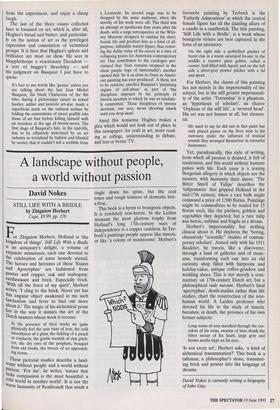A landscape without people, a world without passion
David Nokes
STILL LIFE WITH A BRIDLE by Zbigniew Herbert Cape, £9.99, pp. 170 F. or Zbigniew Herbert, Holland is 'the kingdom of things'. Still Life With a Bridle is an antiquary's delight, a volume of exquisite miniatures, each one devoted to the celebration of some homely utensil. The heroes and heroines of these 'Essays and Apocryphas' are fashioned from Pewter and copper, oak and mahogany, earthenware and brick. Especially brick. With all the force of my spirit', Herbert writes, 'I cling to the brick. Never yet has this angular object awakened in me such fascination and fever to find out more about it.' The magic of his alchemical prose lies in the way it mimics the art of the Dutch masters whose work it reveres:
In the presence of their works we quite physically feel the sour taste of iron, the cold smoothness of a glass, the tickling of a peach or corduroy, the gentle warmth of clay pitch- ers, the dry eyes of the prophets, bouquet from old books, the breeze of an approach- ing storm.
These pictorial studies describe a land- scape without people and a world without Passion. Tor me', he writes, 'nature that lacks compassion is the most beautiful: a cold world in another world'. It is not the warm humanity of Rembrandt that sends a
tingle down his spine, but the cool tones and rough textures of domestic brie- a-brac.
This book is a hymn to bourgeois objects. It is resolutely non-heroic. In the Leiden museum the most glorious trophy from Holland's long 17th-century wars of independence is a copper cauldron. In Ter- boch's paintings people appear like insects, or like 'a colony of mushrooms'. Herbert's favourite painting by Terboch is the `Fatherly Admonition' in which the central female figure has all the dazzling allure of a candle in a candlestick. The title painting, `Still Life with a Bridle', is a work whose bourgeois virtues are best captured in the form of an inventory:
On the right side a potbellied pitcher of burnt clay in a warm saturated brown; in the middle a massive glass goblet, called a roemer, half-filled with liquid; and on the left side a silver-gray pewter pitcher with a lid and spout...
For Herbert, the charm of this painting lies not merely in the impersonality of the subject, but in the still greater impersonali- ty of the artist. Torrentius' is a phantom, an 'hypothesis of scholars', an elusive `Orpheus of the still life', a 'severed head'. His art was not human at all, but elemen- tal.
He used to say he did not in fact paint but only placed paints on the floor next to his canvases; under the influence of musical sounds they arranged themselves in colourful harmonies.
Yet, paradoxically, this style of writing, from which all passion is drained, is full of tenderness; and this world without humans pulses with life. Each essay is a teasing Borgesian allegory in which objects are the masters, with humanity their slaves. 'The Bitter Smell of Tulips' describes the lulipomania' that gripped Holland in the mid-17th century, when a rare bulb might command a price of 1,500 florins. Paintings might be commodities to be traded for 15 florins each, like the pitchers, goblets and vegetables they depicted; but a rare tulip was heroic, sublime and fragile as a dream.
Herbert's impersonality has nothing clinical about it. He deplores the 'boring, obsessively "scientific" studies of contem- porary scholars'. Armed only with his 1911 Baedeker, he travels, like a discoverer, through a land of galleries and of muse- ums, transforming each one into an old curiosity shop filled with harpoons and holiday-cakes, antique coffee-grinders and wedding shoes. This is not merely a com- mentary on 17th-century Dutch art, but a philosophical vade mecum. Herbert's final `apocryphal', death-studies rather than life studies, chart the resurrection of the non- human world. A Leiden professor who devoted his life to the study of insects, becomes, in death, the province of his own former subjects:
Long trains of ants marched through the cor- ridors of his veins, swarms of bees drank the bitter nectar of his heart, large gray and brown moths slept on his eyes.
`Is not every art', Herbert asks, 'a kind of alchemical transmutation?' This book is a talisman, a philosopher's stone, transmut- ing brick and pewter into the language of dreams.
David Nokes is currently writing a biography of John Gay.


















































 Previous page
Previous page